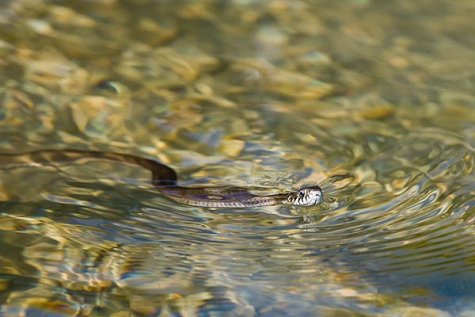Grass snake looking for place to lay eggs?
Photo: Arne Ader
Translation: Liis
Grass snake swimming in the sea
| Grass snake | Nastik |
Grass snakes swim quite willingly, both in fresh and sea water. Whether they manage to catch the quick fish fry is another matter but they are certainly interested in foraging there. They swim keeping the head above the water surface, and when necessary can dive for quite long. Habitats are rather damp places and near bodies of water. The grass snake has been called “koduuss”, homestead snake, because they adapt quite easily to humans. They are not venomous but if you try to handle them they strike out with the head, mouth closed. They may bite too but it isn’t particularly serious. When touched they sometimes secrete an evil-smelling fluid from the anal glands.
On the coast the females lay their leathery-skinned eggs into seaweed banks from July onwards. Inland dunghills, compost heaps or leaf debris are utilized instead; the eggs may be up to a few dozen. It has been noted that several females can lay their eggs in one so-called nest. The nest materials are “self-heating“ as they decay, and thus suitable for incubating the eggs, which takes six to ten weeks.
Grass snakes are steel gray or black. On the sides of the head they have marked yellow, cream or orange patches. The average length of a full-grown reptile is more than a metre, thus quite big, but males may be only half as long.









